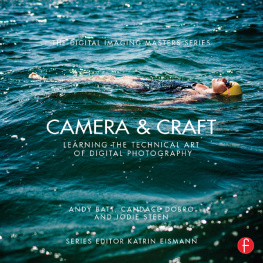Learning to Photograph
Volume 1
Learning to Photograph
Volume 1: Camera, Equipment, and Basic Photographic Techniques
Cora Banek, Georg Banek

Cora and Georg Banek (www.artepictura.de)
Editor: Gerhard Rossbach
Copyeditor: Jeanne Hansen/Maggie Yates
Translator: David Schlesinger
Layout: Cora Banek
Cover Design: Helmut Kraus, www.exclam.de
Printer: Everbest Printing Co. Ltd through Four Colour Print Group, Louisville, Kentucky
Printed in China
ISBN 978-1-937538-20-0
1st Edition 2013
2013 by Cora and Georg Banek
Rocky Nook Inc.
802 East Cota St., 3rd Floor
Santa Barbara, CA 93103
www.rockynook.com
Copyright 2010 by dpunkt.verlag GmbH, Heidelberg, Germany.
Title of the German original: Fotografieren lernen, Band 1: Die technischen Grundlagen:
Kameras, Objektive und Zubehr
ISBN 978-3-89864-648-2
Translation Copyright 2013 by Rocky Nook. All rights reserved.
Library of Congress Cataloging-in-Publication Data
Banek, Cora, 1981
[Fotografieren lernen. English]
Learning to photograph / by Cora Banek, Georg Banek. -- 1st edition. volumes cm
Translation of: Fotografieren lernen.
ISBN 978-1-937538-21-7 (softcover : acid-free paper : volume 2)
1. Photography. I. Banek, Georg, 1969- II. Title.
TR146.B2713 2013
770--dc23
2012051146
Distributed by OReilly Media
1005 Gravenstein Highway North
Sebastopol, CA 95472
All rights reserved. No part of the material protected by this copyright notice may be reproduced or utilized in any form, electronic or mechanical, including photocopying, recording, or by any information storage and retrieval system, without written permission of the publisher.
Many of the designations in this book used by manufacturers and sellers to distinguish their products are claimed as trademarks of their respective companies. Where those designations appear in this book, and Rocky Nook was aware of a trademark claim, the designations have been printed in caps or initial caps. All product names and services identified throughout this book are used in editorial fashion only and for the benefit of such companies with no intention of infringement of the trademark. They are not intended to convey endorsement or other affiliation with this book.
While reasonable care has been exercised in the preparation of this book, the publisher and author(s) assume no responsibility for errors or omissions, or for damages resulting from the use of the information contained herein or from the use of the discs or programs that may accompany it.
This book is printed on acid-free paper.
Foreword
Dear Reader,
The passion for painting with light brings together a diverse group of people. The conversation about the perfect image and its technical and compositional aspects can be approached from very different directions. The images originate in the photographers head, or are a product of chance produced by passing circumstances.
Photographic technology, which Cora and Georg Banek address at the beginning of their Learning to Photograph series, is the vehicle to create an image, and it seems that we can talk about it much more concretely than the images it produces. In discussing the technology of photography and its outcomes, the authors reveal their own philosophy of photography, which I learned about while collaborating with them in the photo lab at the University of Lneburg. They have experience applying the steps and lessons in this book to their own professional photography, and they have passed their methods on to scores of students.
Cora and Georg hope to bring readers closer to their art and techniques, and to engage them in painting with light and the continual process of developmentat times scientifically, at times provocatively, but always with a clear goal of sharing their experience with others.
I hope your experience with this book is enjoyable and beneficial. Dear Cora and Georg: I wish you all the best on your path, since this book is just the beginning of a series about photography and your approach to learning it.
Tobias F. Habura, MA
Cultural scientist and executive editor, DigitalPHOTO
Introduction
Dear Reader,
Were delighted that this book piqued your interest and youve landed here at the introduction. Wed like to tell you why we wrote this book and why we present it in this format.
This book is a part of a two-volume series about photographic technology and visual design; this first volume focuses on the technology of photography. Our goal is to answer two central questions about photo technology: How do cameras and lenses work? How can I realize my photographic purpose? Theres more to these questions than you might first realize.
The first question concerns knowledge about the individual factors of photography, their relationships, and conflicting influences. Answering this question requires an overview of technical components and how they individually and collectively affect the photographic process. We attempt to answer this question in the first eight chapters by introducing general concepts and exploring individual topics in greater detail. This structure will make it easier for you to understand each element within a larger context, and how one variable can affect and influence the overall result.
The second question pertains to the practical application of knowledge. Knowledge about the photographic process cant produce successful images on its own. Answering this question requires that you define what you want, which is based primarily on your photographic goal and the subject in front of your camera. Only when you have a photographic goal can you decide which technical settings to use. In the final four chapters we discuss the application of technology in photographic practice. We help you figure out where you are in the world of photography, and how you can continue to develop as a photographer. You must figure out your photographic status and objectives before you can you apply your craft purposefully.
Its not possible to discuss every technical tool for every photographic situation in one book, and thats not our objective. Rather, we hope to highlight the technical basics of the entire photographic process and explain, in practical terms, how they interact with one another. This is the only way youll be able to understand each element individually and evaluate if it is important and useful for your personal style of taking pictures.
We hope that we can help you launch and further develop your knowledge and skills. The following core beliefs encompass the basis of all of our discussions and explanations in this book:
There is no one right way to photograph; photography is different for each photographer. There are very few things about images and the different ways of producing them that are absolutely correct or incorrect. Canadian nature photographer Freeman Patterson summed this up in a funny and accurate remark: Theres only one rule in photographynever develop colour film in chicken noodle soup.
Photographic technology should never be an end in itself; it should always be the means to an end, employed based on the intention of the photographer and the characteristics of the current situation and subject.
If you share these core beliefs and youre ready to improve your photography in the ways weve described, then this book is for you.
We hope you enjoy it!
Cora and Georg Banek
Next page




